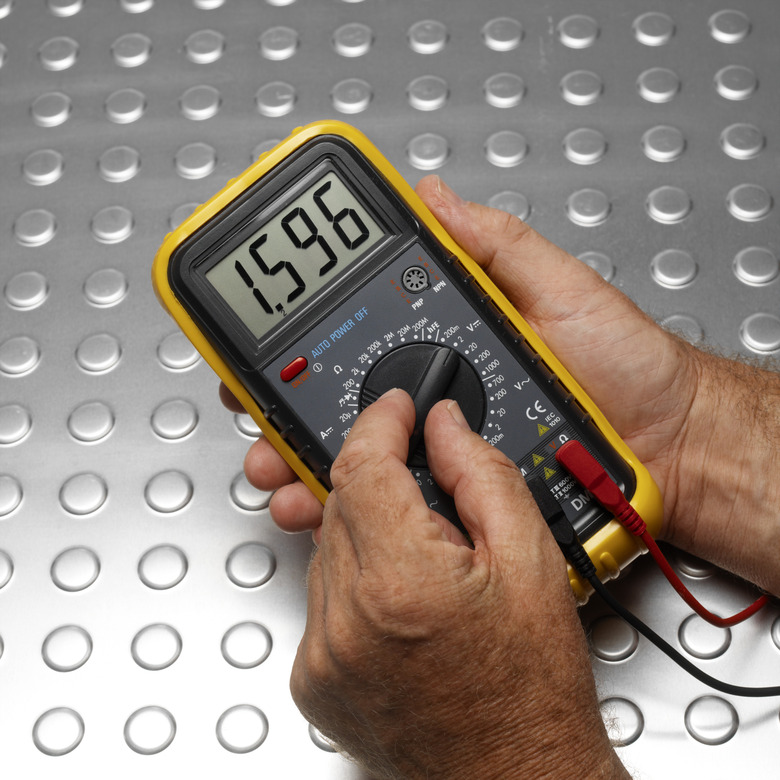Science Projects On Insulators And Conductors
Science projects on insulators and conductors give insight into properties of matter, such as electrical resistance. Using a low-voltage, battery-powered measuring device called a multimeter, you can safely test all kinds of materials to determine whether they are conductors or insulators — and learn what kinds of objects are good examples of each.
Tools and Safety
Tools and Safety
A battery-powered digital multimeter is used to measure conductors and insulators. To use one, set its function knob to "Resistance" or "Ohms;" this displays very low numbers for conductors and "infinity" for insulators. Touch the metal probes to the object you're investigating, but avoid touching the probes with your fingers — if you do, your body's conductivity will give you erroneous readings. To ensure safety for yourself and others, avoid testing any materials or components that are connected to a household alternating current outlet. For example, do not test the conductivity of a lamp that's plugged into an outlet.
What Makes the Best Conductor?
What Makes the Best Conductor?
Metals make good conductors, but not all metals conduct electricity to the same degree. Obtain lengths of different kinds of metal wire, including copper, aluminum and steel, and check the resistance of each with a multimeter. Electrical solder is another wire-like metal material to measure. Do not measure the wire on the spool; unwind a few feet of it and measure a few feet as a separate piece. Divide the resistance of each reading by the length in feet to obtain consistent results in units of ohms per foot. If possible, measure several samples of each kind of metal and find the average for each type. Do one or two metals stand out as having the lowest resistance? Which metals are these?
Conductivity and Corrosion
Conductivity and Corrosion
Rust is a chemical process in which oxygen combines with a metal to form a compound; as it does, the metal's conductivity becomes poorer and its resistance increases. Obtain some iron wire from a hardware store and cut it into equal lengths of a foot or two. Measure the resistance of each length and write down the results, along with the time and date. Prepare a salt water solution by mixing 10 grams of salt with 200 milliliters of water. Place the wire pieces on a paper towel and sprinkle the salt water mixture on them. Once per day at the same time, measure the resistance of each wire and write down the time and measurement. Continue the process for several days. Make a graph of the resistance vs. time and note how the iron's resistance changes. Can you make a general statement about how corrosion affects metal's ability to conduct electricity?
Conductor or Insulator?
Conductor or Insulator?
Assemble a number of household objects, such as an aluminum can, pencil, rubber band, coins, paper towel and other items. Note each one on a piece of paper and measure its resistance with the multimeter. If possible, obtain some mechanical pencil leads and measure their resistance also. If the resistance measurement is a few ohms or less, write "conductor" in your notes; if the resistance is a very large number, or "infinity," write "insulator." For those that fall in between, write "some resistance." Think about the material each object is made of and draw some conclusions about what makes a good conductor or insulator.
Cite This Article
MLA
Papiewski, John. "Science Projects On Insulators And Conductors" sciencing.com, https://www.sciencing.com/science-projects-insulators-conductors-21659/. 24 April 2017.
APA
Papiewski, John. (2017, April 24). Science Projects On Insulators And Conductors. sciencing.com. Retrieved from https://www.sciencing.com/science-projects-insulators-conductors-21659/
Chicago
Papiewski, John. Science Projects On Insulators And Conductors last modified August 30, 2022. https://www.sciencing.com/science-projects-insulators-conductors-21659/
